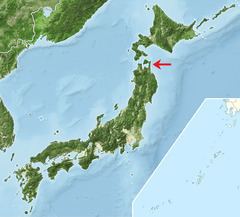Surface elevation 0 meters | ||
 | ||
Highest point – elevation Mount Kamafuse879 meters Highest point – elevation Mount Kamafuse; 879 meters Area 1,876.86 square kilometres (724.66 sq mi) Similar Mount Osore, Cap Ōma, Tsugaru Peninsula, Shimokita Station, Shimofuro Hot Spring | ||
Wild monkeys on shimokita peninsula
Shimokita Peninsula (下北半島, Shimokita-hantō) is the remote northeastern cape of the Japanese island of Honshū, stretching out towards Hokkaidō. It is bordered by the Pacific Ocean to the east, Tsugaru Strait to the north and Mutsu Bay to the west and south. Shaped like an axe pointing west, the peninsula has a thin "axe handle" connecting the mountainous "axe blade" to the mainland of Honshū to the south. The peninsula contains the northernmost point on Honshū, Cape Ōma, and the largest sand dunes in Japan (the Sarugamori Sand Dunes).
Contents
- Wild monkeys on shimokita peninsula
- Map of Shimokita Peninsula Ohatamachi Mutsu Aomori Prefecture 039 4401 Japan
- Shimokita peninsula aomori prefecture
- References
Map of Shimokita Peninsula, Ohatamachi, Mutsu, Aomori Prefecture 039-4401, Japan
Administratively the area is a part of Aomori Prefecture, and the bulk of the area falls within the jurisdiction of the city of Mutsu, with a number of small towns and villages along the periphery. Most of the inhabitants live in coastal areas rather than the mountainous interior.
Portions of the peninsula are within the borders of Shimokita Hantō Quasi-National Park, including Cape Ōma, the coastline of the village of Sai to the south, including seaside cliffs said to resemble Buddhas at Hotokegaura, Cape Shiriya to the northeast, and the volcanic interior of the peninsula, including Mount Osore and Lake Usori. Tourist attractions include Yagen Valley, known for its hot springs.
Economically, the mainstays of the local economy are commercial fishing, forestry, and seasonal tourism. The main commercial centre is the city of Mutsu. The village of Rokkasho, at the southern end of Shimokita Peninsula, home to a range of nuclear facilities.
In 2012, Japan set a new world record for ocean drilling depth, reaching 2,111 meters below the seafloor off Shimokita Peninsula.
